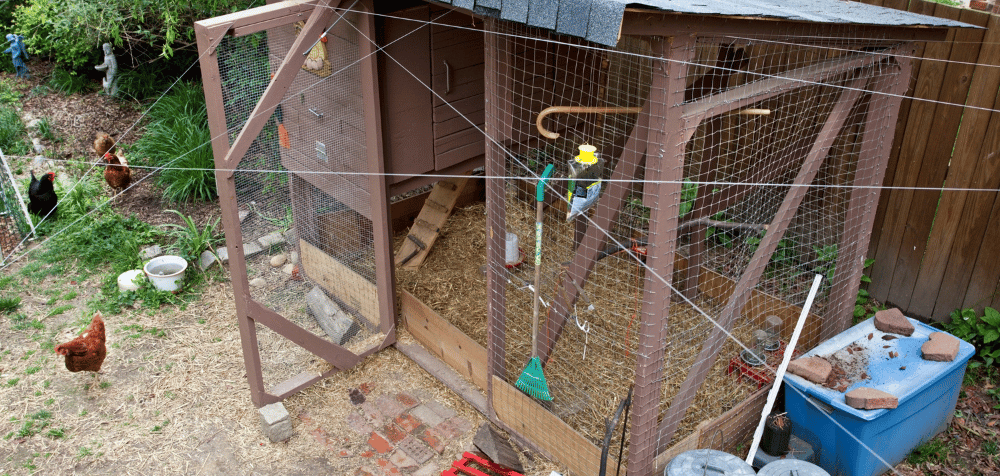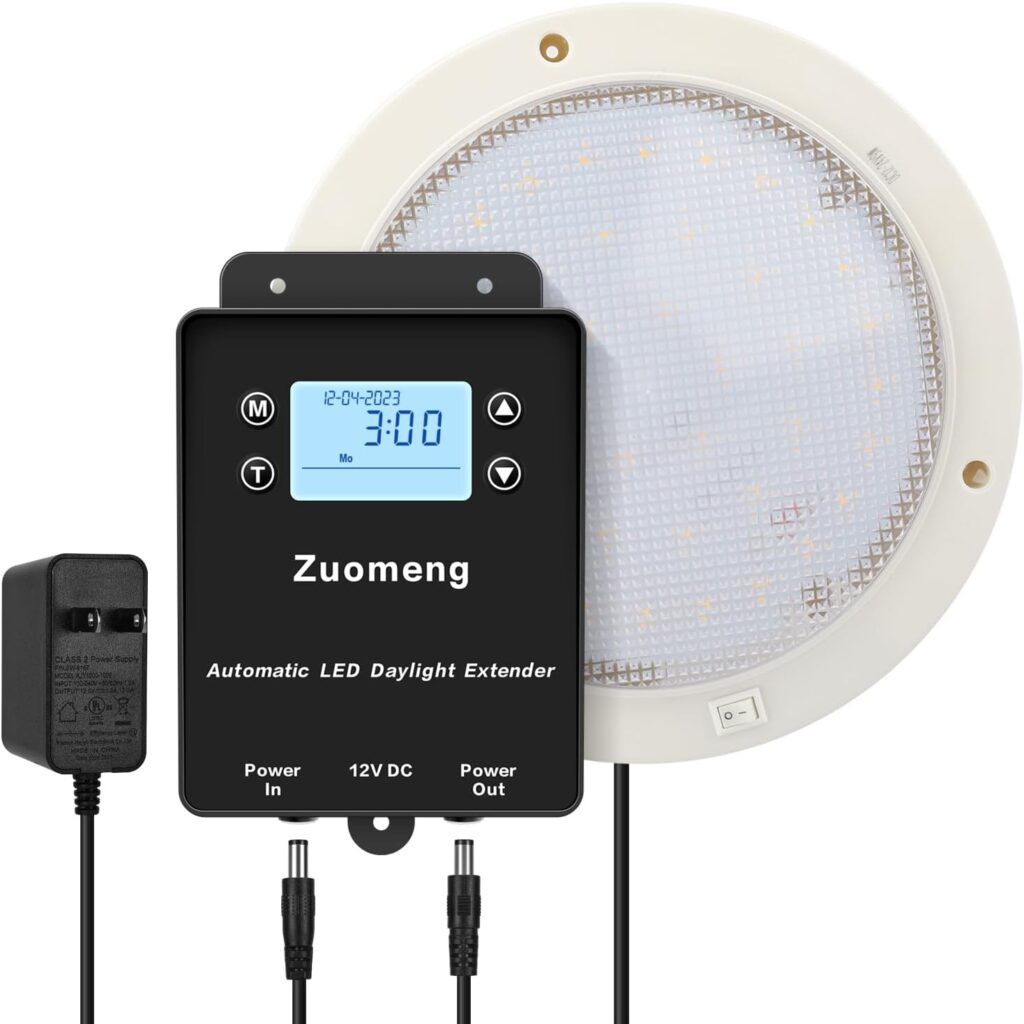A well-designed chicken coop provides security, comfort, and easy maintenance. In this blog, I’ll break down exactly what every chicken coop needs to create an ideal environment for your chickens to thrive.
Knowing your chickens are comfortable, safe, and free from mites or parasites, your chickens will be happier and more productive.
Here are 9 things every chicken coop needs:
1. Safety First: Strong and Secure Structure
Every chicken coop needs to prioritize safety. Chickens are vulnerable to various predators, including raccoons, foxes, dogs, and even hawks.
Your coop should be designed to keep these predators out, ensuring that your chickens are safe day and night.
Key features for a secure coop:
- Durable Walls and Roof: Choose sturdy materials like wood or metal to protect against both the elements and predators.
- Latches and Locks: Use predator-proof latches on all doors and openings.
- Buried Fencing: For added security, bury fencing about 12 inches deep around the coop perimeter to prevent predators from digging underneath.
A well-secured coop structure not only keeps predators out but also gives you peace of mind knowing your chickens are protected.
2. Proper Ventilation for Fresh Air

Good ventilation is essential for chicken health. Every chicken coop needs proper airflow to prevent the buildup of moisture, ammonia, and heat, all of which can lead to respiratory issues in chickens.
Well-ventilated coops are also less likely to harbor bacteria and mold.
Ways to improve coop ventilation:
- Windows and Vents: Add windows or vents at the top of the coop to allow hot air to escape and fresh air to flow in.
- Screened Openings: Cover openings with hardware cloth to keep insects and pests out.
- Adjustable Vents: Opt for adjustable vents if you live in an area with extreme seasonal changes, so you can adapt the airflow depending on the weather.
By keeping the air fresh, your chickens will stay healthier and more comfortable year-round.
3. Nesting Boxes for egg-laying
A crucial part of any coop, every chicken coop needs designated nesting boxes. Chickens are naturally inclined to lay their eggs in a cozy, quiet spot, and having individual nesting boxes helps meet this need.
Tips for creating ideal nesting boxes:
- Provide 1 Box per 3-4 Chickens: This reduces crowding and encourages regular egg-laying.
- Use Soft Bedding: Line the nesting boxes with straw, hay, or wood shavings for a soft, inviting bed.
- Place Nesting Boxes in a Dark Area: Hens prefer to lay their eggs in darker, quieter areas away from the main coop area.
A comfortable nesting area helps reduce egg breakage and makes it easier for you to collect fresh eggs.
4. Perches and Roosting Bars for Resting
Every chicken coop needs sturdy perches or roosting bars where chickens can sleep off the ground. Chickens naturally seek elevated spots to sleep, as this keeps them safe from ground-level predators and away from their droppings.
Things to consider for roosting bars:
- Height and Width: Roosting bars should be about 2 inches wide and positioned a couple of feet off the ground.
- Enough Space: Allow 8-10 inches of space per bird to prevent overcrowding.
- Rounded Edges: Round edges provide a more comfortable grip for their feet, encouraging them to roost rather than crowd together on the ground.
Providing roosting bars helps chickens sleep soundly, promoting their overall health and reducing stress within the flock.
5. Easy-to-Clean Flooring and Bedding

Maintaining cleanliness is key to a healthy coop. Every chicken coop needs easy-to-clean flooring and bedding to prevent disease and odors. While chickens may be hardy, exposure to waste and moisture over time can lead to illness.
Top options for coop flooring and bedding:
- Removable Flooring or Liners: Consider placing removable trays or liners for quick cleaning.
- Absorbent Bedding: Use materials like straw, hay, pine shavings, or sand to absorb moisture and waste.
- Deep Litter Method: This method uses a thick layer of bedding that can be turned over regularly, reducing the frequency of cleanouts.
Clean bedding and flooring not only help with odor control but also create a healthier environment for your flock.
6. Access to Food and Fresh Water
Access to clean water and nutritious food is essential for any chicken coop. Every chicken coop needs a system to ensure food and water are readily available, protected from contaminants, and easy to access.
Food and water tips:
- Automatic Feeders and Waterers: Automatic systems save time and help ensure a steady supply.
- Elevated Placement: Place feeders and waterers off the ground to keep them free of bedding and waste.
- Daily Checks: Make it a habit to check food and water levels daily and clean them regularly to prevent buildup.
Hydrated and well-fed chickens are healthier, more active, and better egg producers.
7. Dust Bathing Area
Chickens love dust baths! Dust bathing is a natural behavior that helps them clean their feathers and remove parasites. Every chicken coop needs a dedicated space for dust bathing, which can prevent them from digging holes elsewhere.
Creating the perfect dust bath:
- Use Fine Sand or Loose Dirt: Fill a shallow box or designated area with sand or loose soil.
- Add Diatomaceous Earth (optional): A sprinkle of food-grade diatomaceous earth can help prevent mites and lice.
- Location Matters: Place the dust bath in a dry area of the coop or run, as wet conditions will clump the dirt.
Providing a dust bath area keeps your chickens’ feathers clean and free from unwanted pests.
8. Lighting and Temperature Control

Proper chicken coop lighting and temperature control are important, especially if you want a steady supply of eggs year-round.
Every chicken coop needs a way to manage temperature extremes and ensure chickens have enough daylight hours to maintain their laying cycle.
Temperature and lighting tips:
- Heating Options for Winter: If you live in a cold climate, a heat lamp or safe warming pad can keep your chickens comfortable.
- Fans or Shade for Summer: Good ventilation and fans can help keep your flock cool in hotter months.
- Timers for Lights: In winter, a timer can extend daylight hours, encouraging regular egg production.
Balanced lighting and climate control help your chickens stay productive and healthy regardless of the season.
9. Chicken Run or Free-Range Area
Every chicken coop needs space for chickens to roam. A chicken run or safe free-range area gives them the opportunity to forage, peck, and exercise, all of which are key to their well-being.
Essential features for a chicken run:
- Secure Fencing: Use high-quality, predator-proof fencing around the run.
- Ample Space: Aim for at least 10 square feet per chicken in the run area.
- Shade and Cover: Provide shaded spots for hot days and cover from rain or snow.
A chicken run gives your flock room to exercise and explore, resulting in happier and healthier birds.
Conclusion
Building the perfect coop doesn’t have to be overwhelming! Every chicken coop needs specific features like proper ventilation, secure structures, cozy nesting boxes, and access to clean food and water to ensure your chickens’ health and happiness. By setting up a comfortable, safe environment, you’re not just taking care of their basic needs—you’re also ensuring that your flock thrives.
With these essentials in place, your chickens will reward you with fresh eggs, a little backyard entertainment, and the satisfaction of knowing they’re happy and healthy.

